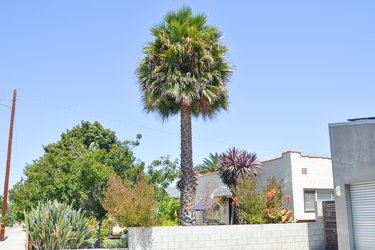
The frizzy yellow fronds on palm trees (family Arecaceae) indicate a magnesium deficiency or another nutrient deficiency. While slow-release fertilizers that include micronutrients can address the long-term issues, a quick treatment of your palm trees with Epsom salt provides short-term relief for the problem. Hardy in U.S. Department of Agriculture plant hardiness zones 6 through 12, depending on the species, both landscape and container-grown palms need regular fertilizer treatments to produce lush green fronds.
Magnesium Deficiency and Palms
Video of the Day
Palm trees show nutritional deficiencies through their fronds. Yellow fronds that hang onto the tree for weeks are often a cry for additional nutrients. The yellow or frizzy fronds indicate a lack of magnesium, potassium or other missing elements. Magnesium deficiency results in yellowing between the veins in the fronds and streaking on new leaves, and in advanced cases, the new leaves are smaller and frizzy and appear scorched.
Video of the Day
Before you reach for fertilizer or Epsom salt, take the time for a soil test. Home soil-test kits are available at home improvement stores and nurseries. Alternatively, you can have your soil tested through the local cooperative extension office.
In addition to magnesium deficiencies in the soil, if it is alkaline with a pH level above 6.5, it can prevent the tree from taking up magnesium. Adding magnesium alone will not resolve the issue with alkaline soils; you may have to change the pH of your soil by applying manganese sulfate products. While Epsom salt does contain sulfate, it won't change the soil pH. Poor drainage or high levels of phosphorus in the soil can also affect the palm's ability to absorb magnesium.
Treat Palm Trees With Epsom Salt
A quick application of an Epsom salt solution is not a cure, but it can give your palm tree a much-needed boost when your soil is severely lacking in magnesium. Put on safety goggles and gloves and then mix 1 teaspoon of Epsom salt per gallon of water and pour it over the soil around the palm tree two or three times a year.
This water-soluble treatment will soak through the soil quickly, so it is not a permanent solution. In addition, avoid using Epsom salt if your soil is already salty, as it will increase the saline levels in the soil around the palm tree's roots.
Fertilize Palm Trees
Applying an 8-2-12 fertilizer specifically formulated for palm trees that contains 4 percent magnesium is recommended by numerous universities instead of using Epsom salt as a magnesium source. This is because the fertilizer delivers a slower release of magnesium, which is better for palms.
If you apply Epsom salt as an additional source of magnesium, wait six weeks before applying a slow-release 8-0-12 or 8-2-12 palm fertilizer that incorporates 4 percent magnesium. Water thoroughly after fertilizing to prevent the salts from burning the tree's roots. Apply palm fertilizer at the recommended intervals on the package or every three months.
Even after applying fertilizers and Epsom salt solutions, you won't see immediate results. The old fronds will not change; they'll still be yellowed and frizzy. Six months after the fertilization schedule is implemented, the new fronds emerging from the crown of the palm should appear healthy and green. Meanwhile, don't remove damaged fronds until they are completely brown and dead; even yellowed fronds absorb the sun's rays.
Other Ways to Help Palms
Grasses and ground covers steal water and nutrients from your palm tree. Remove turf from around the tree and replace it with a 3- to 4-inch layer of coarse bark mulch. Mulch naturally provides nutrients as it decomposes, reduces water evaporation from the soil and discourages weed seed germination.
Water established palm trees deeply two to three times per week when the soil is dry to a depth of 3 to 4 inches. A soaker hose supplies the slow, deep watering that gives the palm tree roots time to absorb the moisture. Adjust your watering schedule according to weather conditions. If you've had heavy rains, reduce or stop watering until the weather clears, but if it's just drizzling, check the soil moisture and water as needed.
- University of Florida IFAS Extension: Magnesium Deficiency in Palms
- Clemson Cooperative Extension: Palm Diseases & Nutritional Problems
- University of Florida IFAS Extention: Phoenix canariensis: Canary Island Date Palm
- University of Florida IFAS Blogs: Happy, Healthy Palms
- Washington State University Extension: Epsom Salt Use in Home Gardens and Landscapes